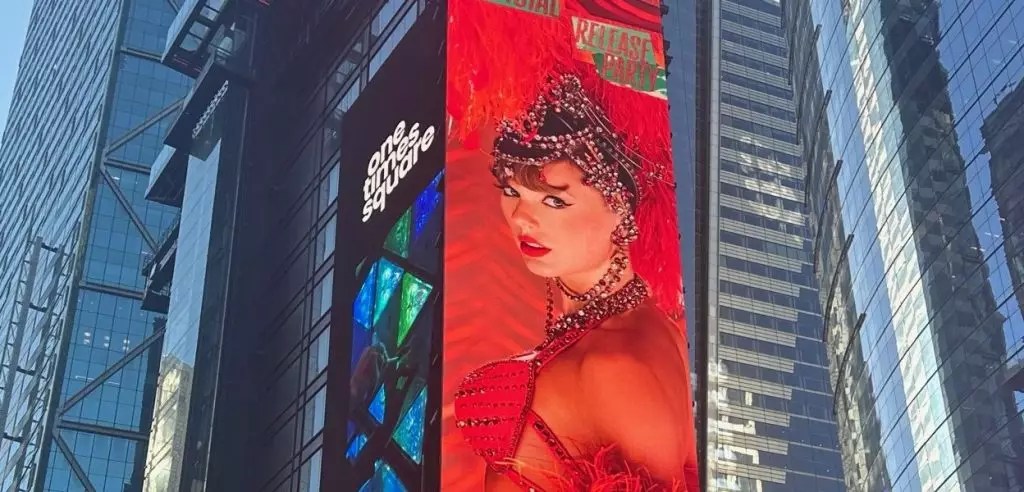In a bold move that has sent shockwaves through the entertainment industry, AMC theaters witnessed an unprecedented surge in ticket presales for Taylor Swift’s “The Official Release Party of a Showgirl,” totaling an astonishing $15 million in just 24 hours. This extraordinary feat exemplifies the power of Swift’s brand, but it also raises questions about whether this is a sustainable trend or a high-risk gamble that could backfire. The immediate success underscores her influence, yet it also exposes the precarious nature of relying heavily on celebrity-driven events to fill seats—particularly in an era where audiences are increasingly discerning and fragmented.
While early projections peg the film’s first-weekend gross between $30 million and $50 million, critics argue that the hype surrounding “Showgirl” may be inflated. The movie, a one-week engagement, seems designed more as a promotional tool for her newest album than a traditional cinematic blockbuster. This mentality of leveraging star power for limited releases is reminiscent of 1990s blockbuster strategies but now confronts a landscape where streaming, piracy, and alternative entertainment options threaten to cannibalize theatrical revenue. If the film’s actual performance fails to match the sky-high presales, it could serve as a sobering lesson about the limits of celebrity-driven box office branding.
The High-Stakes Game of Distribution and Marketing
One of the most striking aspects of this release is its strategic independence from Hollywood’s major studios. Swift and her team have exercised remarkable control, bypassing traditional studio routes to negotiate directly with AMC—an unconventional move that signals a shift in power dynamics within the industry. This approach offers her a greater share of the profits and more leeway over promotional decisions, which, according to critics, could lead to a paradigm where artists consider themselves as much content producers as performers.
Importantly, the marketing strategy for “Showgirl” has been remarkably understated—no trailers, minimal advertising, yet outdoor billboards blanket major cities coast to coast. This minimalist approach might be a calculated gamble to create an aura of exclusivity and curiosity. However, it also runs the risk of underwhelming audiences who may expect more elaborate promotional campaigns, thus potentially limiting the film’s broad appeal. The lower project advertising spend, combined with modest ticket prices, underscores the calculated risk Swift’s team is taking in hopes of turning this brief cinematic endeavor into a lucrative promotional vehicle for her album.
Industry Implications and the Future of Artist-Controlled Releases
The move to release “Showgirl” as a single-week opportunity reflects a broader shift in how artists might leverage their brands in the future. As major studios continue to face audience fatigue and the relentless pressure of streaming giants, artists like Swift are increasingly pathogenic disruptors—taking control of their narratives and revenue streams. Critics may argue that this strategy is a sign of mounting industry chaos, where traditional theatrical releases become peripheral rather than central to a star’s overall earnings.
Furthermore, Swift’s careful calculation to avoid competing directly with other Hollywood releases this October—including high-profile titles like “Avatar: The Way of Water” re-releases and competing blockbusters—illustrates her understanding of market timing. For her, the primary goal isn’t necessarily box office supremacy but ensuring maximum visibility for her new album and maintaining her cultural dominance. It’s a savvy move that, if successful, could encourage more artists to bypass Hollywood filters altogether, leading to an ecosystem where stars become their own content kings and queens.
While critics might scoff at this independence, claiming it undermines traditional Hollywood’s relevance, the reality is that this approach could herald a new era of artist-empowered entertainment. The traditional model of studio-backed releases will likely suffer unless studios innovate or forge stronger partnerships with artists willing to take risks on untested distribution methods. As such, the industry risks becoming more fragmented, with artists and independent entities dictating what audiences see—and when—risking a future where blockbuster filmmaking is replaced by boutique, celebrity-driven events.
A Cautionary Tale or a New Dawn?
The question remains whether the swift ascent of “Showgirl” heralds a new dawn for celebrity economics or is a picturesque bubble destined to burst. The initial numbers—ranging from presale totals to limited box office projections—are promising but inherently unreliable. History suggests that overhyping short-term successes often blinds industry insiders to long-term sustainability. Should the film underperform relative to expectations, the fallout could temper Swift’s bold move, exposing the fragility of her current strategy.
Conversely, if she surpasses expectations, it could solidify her stature not just as a music icon but as a formidable force in multimedia entertainment. Yet, that success hinges on whether fans will genuinely turn out in droves or simply succumb to the thrill of a fleeting cultural moment. The industry needs to ask itself: Is this a harbinger of a seismic shift toward artist-led content control, or just another flashy chapter in a fleeting celebrity chapterbook? As the industry balances on this precipice, the stakes could not be higher for both artists and studios—especially when the ultimate reward is control and profit in an ever-changing entertainment landscape.


Leave a Reply